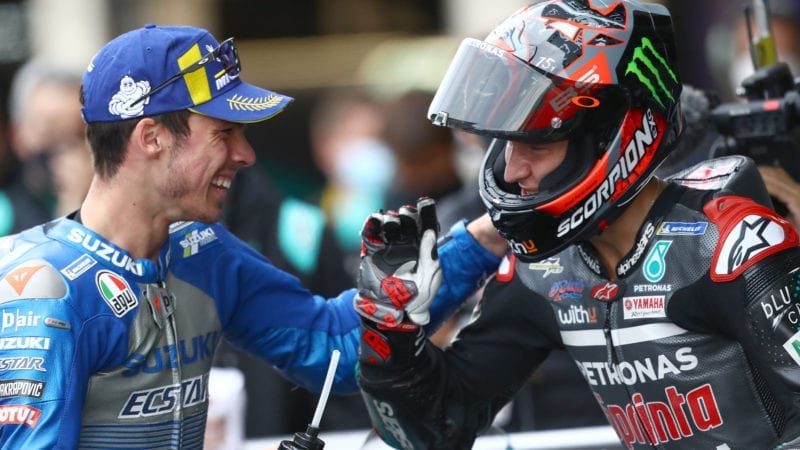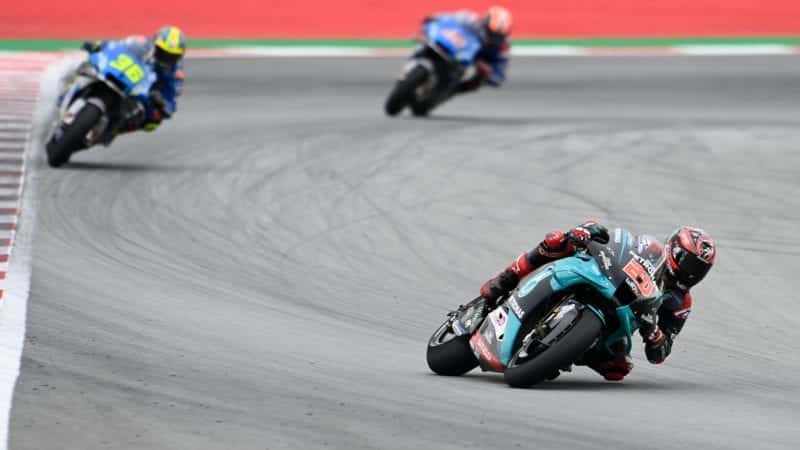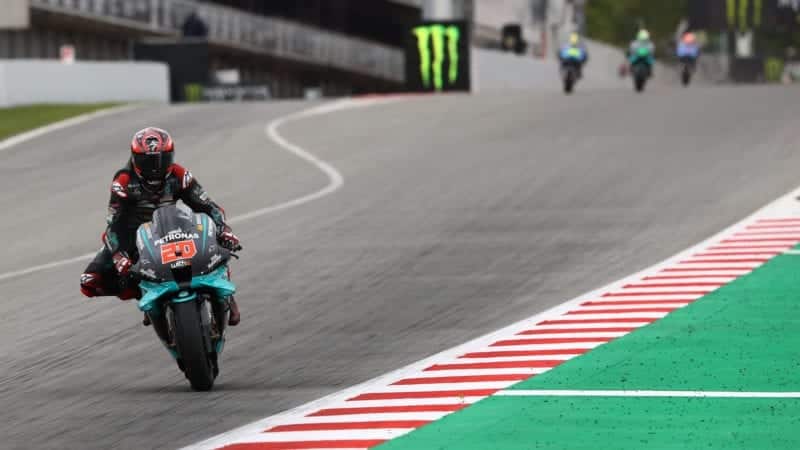It’s Suzuki and Yamaha for the MotoGP title – for the first time since Rainey and Schwantz
Suzuki’s GSX-RR and Yamaha’s YZR-M1 are ruling MotoGP 2020 for one big reason – those black round things at the back of the bikes: 2020 Catalan GP insight part 1

Mir and Quartararo after Sunday’s race – just nine-tenths separated them
Petronas SRT
Six races left and the battle for the 2020 world championship is turning into a Suzuki versus Yamaha duel. Which is a bit of a novelty. The last time that happened was before most of today’s MotoGP riders were out of nappies. It was 1993, to be precise, when Kevin Schwantz on Suzuki’s RGV500 battled with Wayne Rainey on Yamaha’s YZR500 for biking’s biggest prize.
There is one simple reason why it’s Suzuki versus Yamaha for the 2020 MotoGP title – and you know I’ve already told you this – it’s Michelin’s 2020 rear slick.
The tyre’s softer carcass has nobbled the Ducati and Honda V4s, which dominated the last few seasons, and rejuvenated the Suzuki and Yamaha inline-fours, which mostly struggled in recent years.
Hence Sunday’s Catalan GP result: Yamaha riders Fabio Quartararo and Franco Morbidelli first and fourth and Suzuki riders Joan Mir and Álex Rins second and fourth. (This was the first Yamaha/Suzuki top-four lockout since Valencia in October 2000!)
It’s no big deal – in spec-tyre motor sport it’s impossible to build one tyre that will work exactly the same with six different machines. And who’s to say that the recent domination of MotoGP’s V4 wasn’t because Michelin’s previous rear slick favoured them?
In case you don’t believe it can be that simple, here are a few statistics to prove the point, because you won’t understand what’s happening in the 2020 MotoGP championship until you get this.
Between Michelin’s arrival in 2016 and the end of last season – that’s 73 races – there were just three podiums monopolised by YZR-M1 and GSX-RR riders. Already three of this year’s eight podiums have been filled by inline-four riders.
Last year 69 per cent of all MotoGP top-three finishes were scored by V4s. So far this year 63 per cent of top-three finishes have been scored by inline-fours. That’s a huge turnaround.
I’m counting podiums, instead of wins, because this underlines the fact that it’s not merely the absence of Marc Márquez that’s changed the balance of power in MotoGP.
Márquez noted at Jerez that the new rear tyre makes life harder for him and we all know what Ducati’s Andrea Dovizioso (runner-up to Márquez in 2017, 2018 and 2019) thinks of the tyre.
Petronas Yamaha team manager Wilco Zeelenberg thinks otherwise.
“I don’t recognise Ducati’s and Dovizioso’s problems because the tyre works better for us,” he said at Barcelona. “When I hear Dovi explaining why he cannot perform and he cannot brake so late, this isn’t a problem for us because the rear has more grip, so our bike stops better. Also our bike needs to carry corner speed and the tyre helps in this area.”
Of course, Ducati isn’t standing still. It has Pecco Bagnaia using his new rare-groove braking technique that allows him to enter corners at speed without losing the front and then use the front tyre’s grip to turn the bike. He was the fastest rider of all at Misano, but he struggled at Barcelona because the track is so slippery. “Our bike is very strange with no grip,” he said.
Bagnaia’s Pramac team-mate Jack Miller, who beat the Italian to fifth place by a fraction of a second on Sunday – they were the first V4s home – is also getting there.
“We are still trying to understand how the tyre how is working and we are gradually getting there – the smoother I am the faster I go,” said the Australian, whose riding technique is more aggressive than most. “You can’t do anything to upset the tyre. You can’t put the tyre into the corner aggressively and you can’t open the gas aggressively. You have to do everything so silky smooth – that’s the biggest thing.
“Especially at Turn Nine, one of Barcelona’s key points, and at Turns Three and Four, if you put the bike into the corner too aggressively it starts to slide immediately, so you have to put the bike on angle nice and smoothly. And you can’t have too much engine-braking – you’ve got to let the rear go free a bit.”

Suzuki’s Mir and Alex Rins hunt Quartararo’s Yamaha in the final laps
Petronas SRT
Factory Ducati rider Danilo Petrucci – who had his best ride of a miserable season at Barcelona – agrees. “Carrying speed inside the corner is the key with this tyre – this is the reason that some manufacturers are so fast,” he said.
This means that riders of V4 MotoGP bikes must morph their riding techniques towards the inline-four style: smooth cornering arcs that spread the load on the tyre more consistently through the corner. The key is to not load and therefore deform the tyre too much at any point in the corner.
Inevitably, this means that V4 MotoGP engineers must start thinking like inline-four engineers and adjusting their bikes accordingly. Because that’s what you have to do in spec-tyre racing – you modify the rider and modify the bike to work with the tyre.
“What we are working at most is how to use the maximum potential from the new rear tyre,” said HRC technical director Takeo Yokoyama on Saturday. “At the moment we aren’t using the maximum, because there are some areas where we have to change the bike and the traditional philosophy of the Honda. We have to try many things – a lot more than we expected when they changed the tyre. Also the way the riders use the tyre – including their cornering lines – maybe needs to change.”
Honda is suffering its worst season since the days of the oval-piston NR500, due to injuries to its fastest riders, complications with surgeries to its fastest riders and, at Barcelona, an outbreak of Covid within the LCR garage.
Nevertheless LCR rider Takaaki Nakagami is currently HRC’s only real hope for a podium finish. His comments about the 2020 Michelin rear mirror Dovizioso’s.
“This tyre is a bit strange, so you need to change your riding style,” says Nakagami, who rides a 2019-spec RC213V. “Even with the 2019 engine the 2020 tyre is a bit delicate, especially in braking, corner entry and the first part of turning. It depends on grip level, but when you feel more grip the rear always pushes towards the front, so you aren’t able to stop the bike so well in braking, then everything is in delay, so you cannot get off the brakes and you cannot lean the bike. Like Dovi says – you have to change your riding style and use different strategies to change the bike.”
It’s worth adding some historical context here. The last time Suzuki won the premier-class championship was in 2000, when Kenny Roberts Junior beat Honda rookie Valentino Rossi to the title.
Roberts and Suzuki had laid the foundations of their success the previous year, when genius former Team Roberts Yamaha engineer Warren Willing incorporated everything he had learned from the YZR500 into the RGV500.
Roberts and the RGV were super-fast using Michelin’s 17in rear tyre, the same tyre used by all the fast riders. The American stamped his authority on the 2000 championship immediately, with two wins from the first three races.
But then came trouble. Michelin had a new rear slick available. The 16.5in rear put much more rubber on the road at medium lean angles – the point at which riders start feeding serious torque through the tyre.
This was the beginning of the end for Roberts, because riders of Honda’s NSR500 – which had more torque and more horsepower – could use that power earlier in the corner and leave the RGV for dead. After winning two of the first three races of 2000 Roberts only won two more races all year; just enough to take the title.
Why Rossi crashed

Rossi was 100 per cent on the pace on Sunday
Yamaha
Valentino Rossi has come close to winning races on three occasions in the last two years. At Sepang in November 2018, when he led all the way until he crashed four laps from the flag, with Marc Márquez bearing down on him like Jaws. Then at COTA last year, where he led much of the race, only to get beaten by Álex Rins by four-tenths.
And then there was Barcelona on Sunday, where he crashed out of second place, while seven-tenths behind Fabio Quartararo. Would he have been able to beat the Frenchman if he hadn’t slid off? Probably not, but you never know.
Track temperature last weekend was very cold – only 20 degrees – which caused everyone problems with front grip in the track’s few left-handers, despite the top ten all choosing the same soft front/soft rear tyre combo.
“I was pushing because I wanted to try and stay close to Fabio, but today the temperature was very low and Turn Two is always dangerous because you have less temperature in the left of the tyre,” Rossi explained. “Maybe I pushed too much in the entry. Looking at the data it was really, really, really similar to the lap before, but with this temperature I need to pay more attention to the left of the tyres. It was a great, great shame because we needed a podium.”
MotoGP riders walk the line at every corner, but the line between glory and gravel trap at the Turn Two left-hander is so narrow it’s almost invisible.
Rossi was in good company in the gravel trap. Eighteen of the 42 MotoGP and Moto2 crashes during the weekend were at Turn Two – that’s almost half the total at one corner of 14.
The problem at Barcelona’s second corner is three-fold. First, the left sides of the tyres haven’t touched the asphalt for almost 40 seconds, since Turn 11, so they’ve lost heat. Second, the whole of the front tyre does no real work down the 1km/0.65 mile, 350kmh/215mph start/finish straight, so it’s cooling all the time. Third, Turn Two is the second part of a right/left flipflop esses, so when the rider flicks the bike into the left-hander the front tyre isn’t always fully settled and therefore loaded from the change of direction.
Turn Two is a perfect storm on a cold day and Rossi was just one of its many, many victims.
Until the nine-time world champion’s race went awry it was going very well. Aided by Michelin’s 2020 rear tyre Yamaha’s M1 was dominating the race, with Suzuki coming on strong in the later stages, once the GSX-RR and its rear tyre had entered their sweet spot.
“Fabio, Franky [Morbidelli] and me were fastest in the first part of the race,” added Rossi. “We started very, very smooth and we had good pace. I tried to ride very sweet with the front and rear tyres because like everyone I knew we would suffer later.
“Then Franky made a mistake [when he locked the front entering Turn One on lap 14 and nearly crashed] and from that moment I pushed because I wanted to stay close to Fabio and because I knew the Suzukis are very strong at the end of the race.
“We were very close – maybe Fabio was a bit better – but from the moment the tyres went down a lot Fabio lost very much in those laps. We will never know [what would’ve happened] because I crash, but if I had been able to slow down a bit less and had been a bit better in the last laps maybe I could win.”
Rossi was distraught by his crash (his second in two races) but his half-brother Luca Marini’s Moto2 victory went some way to cheer him up
“The victory of Luca helped me swallow my mistake,” he said. “His style is perfect and he never makes a mistake. Great, great congratulations to him, and I hope he doesn’t find a place in MotoGP and remains in Moto2!”
Only one Yamaha rider didn’t excel on Sunday. Maverick Viñales had shone at his brightest at Misano the previous weekend but his Barcelona race was as gloomy as its gets: swamped in the drag race to the first corner – from fifth on the grid to 13th in a few hundred metres – he was stuck in the pack for the entire 24 laps.
When the super-talented Spaniard has a bad race there are always reasons – Moto2 rubber, a full fuel tank, lack of top speed and so on. There may be truth in all these reasons, but (as I wrote last Monday) the real problem has to be inside his head. Viñales doesn’t like Sundays and it’s up to Yamaha management to encourage him to see a sports psychiatrist who can fix that problem.
MotoGP’s 2020 climax: Winter is coming!

The high-speed entry to Barcelona’s main straight reduced Yamaha’s top speed handicap
Petronas SRT
Quartararo’s long-awaited and much-needed first victory since Jerez, six races and nine weeks ago, regained him the championship lead from Andrea Dovizioso, who on Sunday was the unfortunate victim of a Danilo Petrucci/Johann Zarco chain reaction on the second corner of the first lap.
The 21-year-old Frenchman goes into his home GP in two weeks’ time holding an eight-point advantage over Joan Mir, who is the most consistent rider of the moment, with four podiums from the last five races.
Two important factors helped Quartararo: Barcelona suits his swooping riding style more than Misano and the Yamaha’s top-speed disadvantage was significantly less than it had been at Red Bull Ring, where he had two disastrous rides. In Austria the longest straight is 0.6km long, but Quartararo’s bike was the slowest bike on the grid, while at Barcelona, where the straight is 1km long, his M1 was ninth fastest through the speed trap.
Two main reasons for this. First, Barcelona is a less thirsty track than Red Bull Ring, so the M1 suffers less from power reductions in its fuelling system.
Second, the entry to Barcelona’s straight is considerably faster, so M1 riders can use their superior corner speed to enter the straight faster than their rivals. Riders enter the Barcelona start/finish at 130kmh/80mph in third gear, against Red Bull Ring, where the first and fastest straight starts at 100kmh/80mph in second gear.
The biggest factor in deciding who wins the 2020 MotoGP championship will be the weather and track conditions at the last four venues – Le Mans and Aragon in October and Valencia and Portimao in November.
How will each of the bikes work with low-track temperatures, how will the tyres work? Long-range weather forecasts for the French GP on October 11 predict an ambient temperature of just 12 degrees, which will make the asphalt treacherous to say the least.
KTM has been one of the revelations of this season, with the RC16 scoring its first two MotoGP victories. However, Sunday’s chilly Barcelona race proved that the bike does not like cold tracks. KTM riders struggled all weekend and the riders and engineers know why. Czech GP winner Brad Binder was downbeat about MotoGP’s upcoming Covid autumn schedule. “Winter is coming,” he said.

